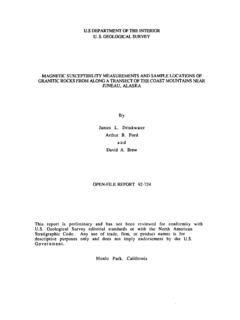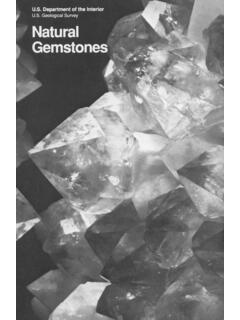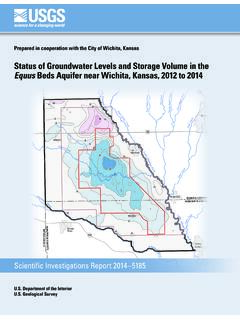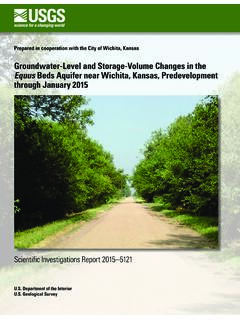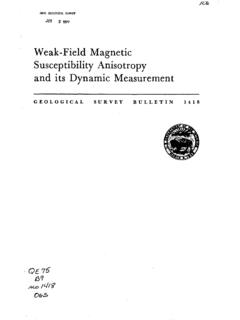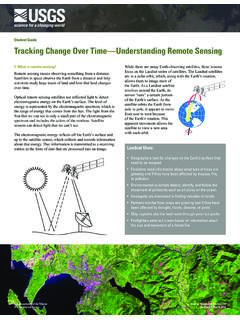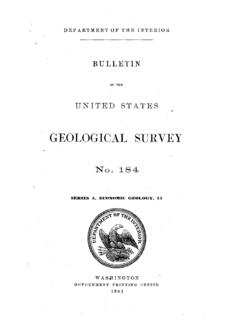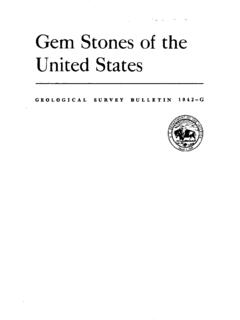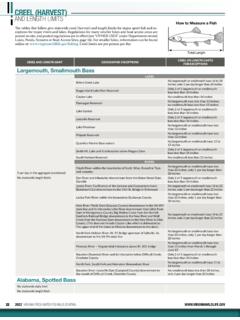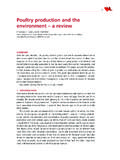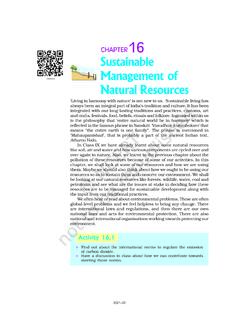Transcription of A Land Use and Land Cover Classification System for Use ...
1 A land Use and land Cover Classification System for Use with Remote Sensor Data GEOLOGICAL SURVEY PROFESSIONAL PAPER 964 A land Use and land Cover Classification System for Use with Remote Sensor Data By JAMES R. ANDERSON, ERNEST E. HARDY, JOHN T. ROACH, and RICHARD E. WITMER GEOLOGICAL SURVEY PROFESSIONAL PAPER 964 A revision of the land use Classification System as presented in Geological Survey Circular 671 UNITED STATES GOVERNMENT PRINTING OFFICE, vVASHINGTON 1976 UNITED STATES DEPARTMENT OF THE INTERIOR JAMES G. WATT, Secretary GEOLOGICAL SURVEY Dallas L. Peck, Director First printing 1976 Second printing 1976 Third printing 1978 Fourth printing 1983 For sale by the Distribution Branch, Geological Survey, 604 South Pickett Street, Alexandria, VA 22304 FIGURE TABLE CONTENTS Abstract Introduction ~eed for standardization ---------------------------------------- ----------Historical development of the Classification System ---------------------------Designing a Classification System for use with remote.
2 Sensing techniques _____ _ Classification criteria _____ ------_____ _ Developing the Classification System ---------------------------------------- Using the Classification System _____ _ Definitions ---------------------------------------- -----------------------Urban or Built-up land ---------------------------------------- ------Agricultural land ---------------------------------------- ------------Rangruand ---------------------------------------- -------------------Forest land _____ _ VVater ---------------------------------------- -----------------------VVetland ---------------------------------------- ---------------------Barren land ---------------------------------------- -----------------Tundra ---------------------------------------- ----------------------Perennial Snow or Ice ---------------------------------------- --------Map presentation --------------------------------____ ---------------------Selected bibliography -----------------------ILLUSTRATIONS Page 1 1 2 3 4 5 7 9 10 10 13 14 16 17 17 18 20 21 22 27 1.
3 Map of ,a part of the Indianapolis, , 1:250,000 quadrangle, showing Level I land use and land Cover ---------------------------------------- ---------------------------------------- -----23 2. Map of a part of the Indianapolis, , 1:250,000 quadrangle, showing Level II land use and land Cover ---------------------------------------- ---------------------------------------- ------24 3. Map of a part of the Maywood, Ind., 1:24,000 quadrangle, showing Level II land use and land Cover __ 25 4. Map of a part of the Maywood, Ind., 1:24,000 quadrangle, showing Level III land use and land Cover __ 26 TABLES 1. Major uses of land , United , 1969 -------------- ---------------------------------------- ----2~ land use and land Cover Classification System for use with remote sensor data -----------------------3.
4 Standard land use code-first level categories -------- ---------------------------------------- ----4. Level I land use color code ---------------------------------------- --------------------III 8 8 9 22 A land USE AND land Cover Classification System FOR USE WITH REMOTE SENSOR DATA By JAMEs R. ANDERSON, ERNEST E. HARDY, JoHN T. RoAcH, and RICHARD E. WITMER ABSTRACT The framework of a national land use and land Cover Classification System is presented for use with remote sensor data. The Classification System has been developed to meet the needs of Federal and State agencies for an up-to-date overview of land use and land Cover throughout the country on a basis that is uniform in categorization at the more generalized first and second levels and that will be receptive to data from satellite and aircraft remote sensors.
5 The pro-posed System uses the features of existing widely used classi-fication systems that are amenable to data derived from re-mote sensing sources. It is intentionally l eft open-ended so that Federal, regional, State, and local agencies can have flexibility in developing more detailed land use classifications at the third and fourth levels in order to meet their particular needs and at the ~arne time rema:in compatible with each other and the national System . Revision of the land use Classification System as presented in Geological Survey Circular 671 was undertaken in order to incorporate the re-sults of extensive testing and review of the categorization and definitions. INTRODUCTION A modern nation, as a modern business, must have adequate information on many complex interrelated aspects of its activities in order to make decisions.
6 land use is only one such aspect, but knowledge about land ~se and land Cover has become increas-ingly important as the Nation plans to overcome the problems of haphazard, uncontrolled develop- ment , deteriorating environmental quality, loss of prime agricultural lands, destruction of important wetlands, and loss of fish and wildlife habitat. land use data are needed in the analysis of environmental processes and problems that must be understood if living conditions and standards are to be improved or maintained at current levels. One of the prime prerequisites for better use of land is information on existing land use patterns and changes in land use through time. The Department of Agriculture (1972) reported that during the decade of the 1960's, 730,000 acres (296,000 hectares) were urbanized each year, trans-portation land uses expanded by 130,000 acres (53,000 hectares) per year, and recreational area increased by about 1 million acres ( 409,000 hec-tares) per year.
7 Knowledge of the present distribu-tion and area of such agricultural, recreational, and urban lands, as well as information on their chang-ing proportions, is needed by legislators, planners, and State and local governmental officials to deter-mine better land use policy, to project transporta-tion and utility demand, to identify future develop'"" ment pressure points and areas, and to implement effective plans for regional development. As Claw-son and Stewart ( 1965) have stated: In this dynamic situation, accurate, meaningful, current data on land use are essential. If public agencies and private organizations are to know what is happening, and are to make sound plans for their own futwre action, then reliable infor-mation is critical. The variety of land use and land Cover data needs is exceedingly broad.
8 Current land use and land cov-er data are needed for equalization of tax assess-ments in many States. land use and land Cover data also are needed by Federal, State, and local agencies for water-resource inventory, flood control, water-supply planning, and waste-water treatment. Many Federal agencies need current comprehensive inven-tories of existing activities on public lands combined with the existing and changing uses of adjacent private lands to improve the management of public lands. Federal agencies also need land use data to assess the environmental impact resulting from the development of energy resources, to manage wildlife resources and minimize man- wildlife ecosystem conflicts, to make national summaries of land use patterns and changes for national policy formula.
9 Tion, and to prepare environmental impact state-ments and assess future impacts on environmental quality. 1 2 A land USE AND land Cover Classification System FOR USE WITH REMOTE SENSOR DATA NEED FOR STANDARDIZATION For many years, agencies at the various govern-mental levels have been collecting data about land , but for the most part they have worked independent-ly and without coordination. Too often this has meant duplication of effort, or it has been found that data collected for a specific purpose were of little or no value for a similar purpose only a short time later. There are many different sources of information on existing land use and land Cover and on change that are occurring. Local planning agencies make use of detailed information generated during ground surveys involving enumeration and observation.
10 In-terpretation of large-scale aerial photographs also has been used widely (Avery, 1968). In some cases, supplementary information is inferred on the basis of utility hookups, building permits, and similar in-formation. Major problems are present in the appli-cation and interpretation of the existing data. These include changes in definitions of categories and data-collection methods by source agencies, incomplete data coverage, varying data age, and employment of incompatible Classification systems. In addition, it is nearly impossible to aggregate the available data because of the differing Classification systems used. The demand for standardized land use and land Cover data can only increase as we seek to assess and manage areas of critical concern for environ-mental control such as flood plains and wetlands, energy resource development and production areas, wildlife habitat, recreational lands, and areas such as major residential and industrial development sites.
